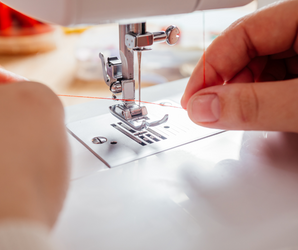Know Your Needles
29th Sep 2022
Sewing machine needles. What do I need to know? Sewing machines require a needle and thread to function. Using a good quality of both of these items makes sense, providing us with a smooth and enjoyable sewing experience. Matching up the proper needle size with proper thread size can save us a lot of frustration and time.

The Anatomy of a Needle
The shank is the top of the needle, having a flat back and round front. This is the part of the needle that is inserted into the machine. The shaft, or the blade, is the body of a needle, and the thickness of this determines the size. The groove is located on the front of the blade and is where the thread hides. The eye is the hole where we place the thread. The scarf is a groove on the back, which acts with the bobbin case to form the stitch. The point is the tip of the needle which comes in many options. A needle size is reflected in the number, the larger the number, the larger the needle. European numbers go from 60 to 120 and the American numbers go from 8 to 19. Thread is just the reverse, if it happens to have a number at all.

A universal needle is the most commonly used needle for piecing our quilt tops. This needle has a slightly rounded point, however it is sharp enough to pierce our woven cottons. The size of needle will be determined by the thread you are using. If your thread is breaking try a larger needle. The most common advice I provide to my fellow sewers is in regard to the needle and thread relationship. You have probably seen quilting needles and wondered about the difference. This needle is designed with a special tapered point to sew through the layers of fabric and batting as we are quilting. It is not used for piecing our quilt blocks, as these needles usually cost more and do not provide any better piecing benefits.

How often should I change my needle? The industry recommendation is after 8 to 12 hours of sewing. That refers to needle moving and actual sewing time, not how long we are in our sewing world. I change with every other full bobbin, which works better for me. If you are getting skipped stitches, check the needle for burrs or a slight bend. Hitting a pin can damage your needle.

Marty Walsh
Marty is a lifelong sewer, a member of several quilting guilds, and has taught sewing for beginners at the local community college. Her current passion, in addition to sewing, is servicing older sewing machines. She also works with other sewing community members to find and rehab machines to send to third-world countries.

